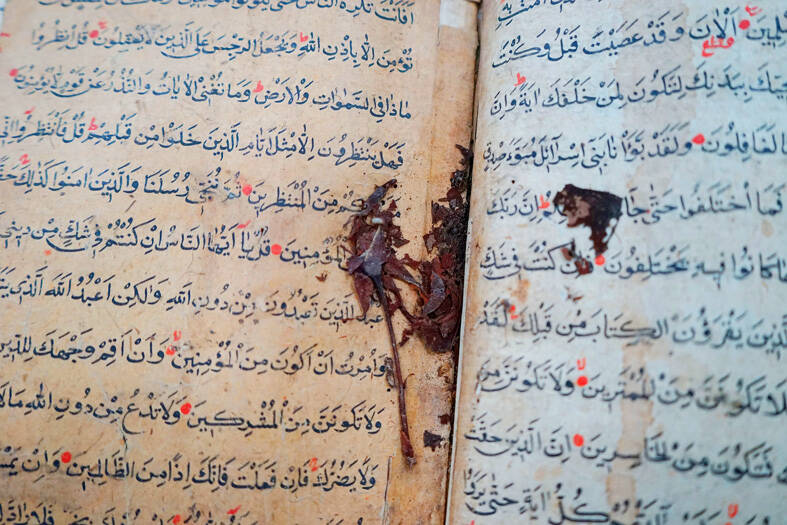The restoration of a 500-year-old handwritten Koran, which had been heavily damaged by the elements, is likely to be completed by the end of this month, the National Taiwan Library said last week.
The book’s cover and binding are the final elements to be repaired, said Hsu Mei-wen (徐美文), a book restorer at the national library’s Book Hospital.
Hsu specializes in the restoration of ancient texts and calligraphy.

Photo courtesy of Hsu Mei-wen
The artifact was presented two years ago as a gift to Dharma Master Cheng Yen (證嚴法師), founder of the Taiwan-based Buddhist Tzu Chi Charity Foundation, by Faisal Hu (胡光中), a Tzu Chi volunteer and Muslim based in Turkey.
The 75 chapters of text were handwritten by four different people, using different inks, and was completed some time in the 15th or 16th century, Hsu said.
Cheng Yen was leafing though her special gift when she saw what looked like ants on some of the pages, and contacted the national library to inspect the book, Hsu said.
The “ants” were actually cigarette beetles, which are commonly found in old books, she said.
An inert gas was applied to eradicate the insects.
The library further endeavored to restore the Koran, which was a long and painstaking process, with a day required to repair two pages, Hsu said.
Sourcing appropriate materials also took much time and effort, she said, adding, for example, that the library had to find linen fibers to match the material of the Koran’s pages.
Given the lack of suppliers, finding the linen took eight months, she said.
The material was eventually discovered in the national library’s warehouse. It was later dyed with a mineral pigment to create a similar look as that in the handwritten edition of the Koran.
Hsu removed old dust, seeds and human hair from the tome, all of which she collected plans to display alongside the restored Koran in July, she said.
Hsu said that while she is neither Buddhist nor Muslim, she chose out of respect not to eat pork during the time she was restoring the Koran.

WANG RELEASED: A police investigation showed that an organized crime group allegedly taught their clients how to pretend to be sick during medical exams Actor Darren Wang (王大陸) and 11 others were released on bail yesterday, after being questioned for allegedly dodging compulsory military service or forging documents to help others avoid serving. Wang, 33, was catapulted into stardom for his role in the coming-of-age film Our Times (我的少女時代). Lately, he has been focusing on developing his entertainment career in China. The New Taipei District Prosecutors’ Office last month began investigating an organized crime group that is allegedly helping men dodge compulsory military service using falsified documents. Police in New Taipei City Yonghe Precinct at the end of last month arrested the main suspect,

A cat named Mikan (蜜柑) has brought in revenue of more than NT$10 million (US$305,390) for the Kaohsiung MRT last year. Mikan, born on April 4, 2020, was a stray cat before being adopted by personnel of Kaohsiung MRT’s Ciaotou Sugar Refinery Station. Mikan was named after a Japanese term for mandarin orange due to his color and because he looks like an orange when curled up. He was named “station master” of Ciaotou Sugar Refinery Station in September 2020, and has since become famous. With Kaohsiung MRT’s branding, along with the release of a set of cultural and creative products, station master Mikan

RISING TOURISM: A survey showed that tourist visits increased by 35 percent last year, while newly created attractions contributed almost half of the growth Changhua County’s Lukang Old Street (鹿港老街) and its surrounding historical area clinched first place among Taiwan’s most successful tourist attractions last year, while no location in eastern Taiwan achieved a spot in the top 20 list, the Tourism Administration said. The listing was created by the Tourism Administration’s Forward-looking Tourism Policy Research office. Last year, the Lukang Old Street and its surrounding area had 17.3 million visitors, more than the 16 million visitors for the Wenhua Road Night Market (文化路夜市) in Chiayi City and 14.5 million visitors at Tainan’s Anping (安平) historical area, it said. The Taipei 101 skyscraper and its environs —

Taiwan on Friday said a New Zealand hamburger restaurant has apologized for a racist remark to a Taiwanese customer after reports that it had first apologized to China sparked outrage in Taiwan. An image posted on Threads by a Taiwanese who ate at Fergburger in Queenstown showed that their receipt dated Sunday last week included the words “Ching Chang,” a racial slur. The Chinese Consulate-General in Christchurch in a statement on Thursday said it had received and accepted an apology from the restaurant over the incident. The comment triggered an online furor among Taiwanese who saw it as an insult to the